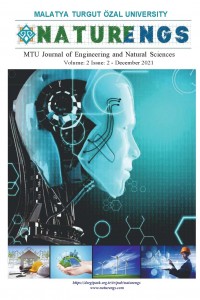Abstract
References
- [1] Çengel, Y. A. (2015). Heat Transfer 5th ed., McGraw Hill, New York.
- [2] Gudmundsson, S. (2014). Aircraft Drag Analysis (Chapter 15), General Aviation Aircraft Design, Butterworth-Heinemann, p.661-760
- [3] White, M., F. (2010). "Fluid Mechanics," Section 7.1 (7th edition)
- [4] Schlichting, H. 1960. Boundary Layer Theory, McGraw-Hill New York.
- [5] Subha, R., Drozario, A. M., Sreeshin, M. (2020). Study on Various Types of Nose Cone Profiles at Supersonic Speed through Analytical, Experimental and Numerical Simulation Methods, Journal of Xidian University. 14. 10.37896/jxu14.6/312. VOLUME 14, ISSUE 6, 2020. 2651-2675.
- [6] Iyer, A. R., Pant, A. (2020). A Review On Nose Cone Designs for Different Flight Regimes, International Research Journal of Engineering and Technology (IRJET), Volume: 07 Issue: 08, 3546-3554.
- [7] GICHD. (2017). Characterisation of explosive weapons study, annex E – Mk 82 aircraft bomb, Geneva International Centre for Humanitarian Demining, Geneva, Switzerland.
- [8] Crowell S., Gary A. (1996). The descriptive geometry of nose cones, https://web.archive.org/web/20110411143013/http://www.if.sc.usp.br/~projetosulfos/artigos/NoseCone_EQN2.PDF Retrieved: 24.04.2021.
- [9] ANSYS, Inc. (2011). Ansys Fluent 14.0: Theory Guide, 275 Technology Drive Canonsburg, PA 15317.
- [10] Gurney, R. W. (1943). The Initial Velocities of Fragments from Bombs, Shells and Grenades, BRL-405. Ballistic Research Laboratory, Aberdeen, Maryland. USA.
- [11] United Nations Office for Disarmament Affairs. (2015). International Ammunition Technical Guideline (2nd ed.). New York, NY: United Nations Headquarters.
- [12] Watts, A., Curtis S., Braswll J., Underwood M. (2014). Missile Design Tool (MDT) User’s Guide, Commander, U.S. Army Research, Development, and Engineering Command, Redstone Arsenal.
Effects of Different Nose Cone Designs on Trajectory and Impact Angle of Smart Fire Extinguishing Ammunition
Abstract
A nose cone is the conically shaped tip part of a missile, bomb or aircraft, used to regulate the behavior of oncoming airflow and minimize drag. In this study, the effects of different nose cone designs on the trajectory and impact angle of smart fire extinguishing ammunition were investigated. For this purpose, three different types of ammunition with different nose cone profiles were designed: spherically blunted conic nose cone, spherically blunted tangent ogive nose cone and truncated tangent ogive nose cone. A virtual wind tunnel was created in the computer environment and a CFD software was used to calculate the drag coefficients for each design. By applying Newton's second law of motion, the horizontal distance the ammunition received before striking fire, impact speed, and impact angle were calculated. The obtained results were compared using One-Way ANOVA (analysis of variance) in order to determine whether there is statistical evidence that the associated population means are significantly different. It was determined that the three types of nose cone designs examined did not have a significant effect on the impact speed, impact angle and horizontal distance of the ammunition at the investigated speeds and altitudes. On the other hand, flame detection, distance measurement and impact sensors, which should be in the smart fire extinguishing ammunition, should be on the plane at the front of the ammunition and in contact with the external environment. In order to place these sensors in the nose cone, a truncated tangent ogive nose cone was chosen as the nose cone for the smart fire extinguishing ammunition.
References
- [1] Çengel, Y. A. (2015). Heat Transfer 5th ed., McGraw Hill, New York.
- [2] Gudmundsson, S. (2014). Aircraft Drag Analysis (Chapter 15), General Aviation Aircraft Design, Butterworth-Heinemann, p.661-760
- [3] White, M., F. (2010). "Fluid Mechanics," Section 7.1 (7th edition)
- [4] Schlichting, H. 1960. Boundary Layer Theory, McGraw-Hill New York.
- [5] Subha, R., Drozario, A. M., Sreeshin, M. (2020). Study on Various Types of Nose Cone Profiles at Supersonic Speed through Analytical, Experimental and Numerical Simulation Methods, Journal of Xidian University. 14. 10.37896/jxu14.6/312. VOLUME 14, ISSUE 6, 2020. 2651-2675.
- [6] Iyer, A. R., Pant, A. (2020). A Review On Nose Cone Designs for Different Flight Regimes, International Research Journal of Engineering and Technology (IRJET), Volume: 07 Issue: 08, 3546-3554.
- [7] GICHD. (2017). Characterisation of explosive weapons study, annex E – Mk 82 aircraft bomb, Geneva International Centre for Humanitarian Demining, Geneva, Switzerland.
- [8] Crowell S., Gary A. (1996). The descriptive geometry of nose cones, https://web.archive.org/web/20110411143013/http://www.if.sc.usp.br/~projetosulfos/artigos/NoseCone_EQN2.PDF Retrieved: 24.04.2021.
- [9] ANSYS, Inc. (2011). Ansys Fluent 14.0: Theory Guide, 275 Technology Drive Canonsburg, PA 15317.
- [10] Gurney, R. W. (1943). The Initial Velocities of Fragments from Bombs, Shells and Grenades, BRL-405. Ballistic Research Laboratory, Aberdeen, Maryland. USA.
- [11] United Nations Office for Disarmament Affairs. (2015). International Ammunition Technical Guideline (2nd ed.). New York, NY: United Nations Headquarters.
- [12] Watts, A., Curtis S., Braswll J., Underwood M. (2014). Missile Design Tool (MDT) User’s Guide, Commander, U.S. Army Research, Development, and Engineering Command, Redstone Arsenal.
Details
| Primary Language | English |
|---|---|
| Journal Section | Research Articles |
| Authors | |
| Publication Date | December 18, 2021 |
| Submission Date | June 8, 2021 |
| Acceptance Date | June 19, 2021 |
| Published in Issue | Year 2021 Volume: 2 Issue: 2 |


